
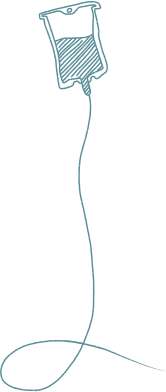
UNDERSTANDING BETA-THALASSEMIA
YOUR BODY AND
BETA-THALASSEMIA
Let’s start by talking about terms: cells, DNA, genes, and proteins. It is
important to know these terms so that you can understand how your body
works. Then, you can learn how genetic diseases like beta (β)-thalassemia
affect the functions of your body.
Where to Start: Cells, DNA, Genes, and Proteins
CELLS
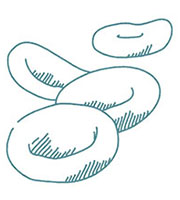
Cells are the building blocks of all living things. Inside cells is DNADNAa material that is in almost all living things that carries genetic information, which tells the cell what to do.

DNA/GENES
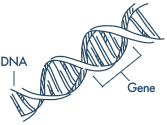
GenesGenea sequence of DNA responsible for controlling inherited traits are made of DNA. They are like an instruction manual for making the different parts of your body, including telling the cell how to make proteins.

PROTEINS
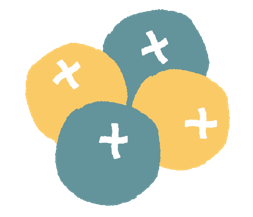
ProteinsProteinthe working component of your cells that is required for the structure, function, and regulation of your body’s tissues and organs are the workers of the cell. They perform different functions within your body to keep you healthy. Proteins also contribute to the structure, function, and regulation of your organs.

ORGANS/BODY
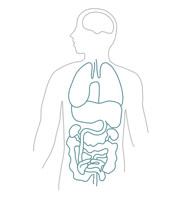

In order to work properly, your body relies on the ways that cells, genes, and proteins work together.
For instance, genes can instruct cells to make proteins that facilitate communication between cells in different parts of your body.
How Genes and Proteins Work Together
To better understand how genes and proteins work together, it may be helpful to first look at an example that is not related to beta-thalassemia: eye color.
As we said in the previous section, genes provide instructions to your cells. The instructions provided by your unique set of genes tell your cells to make certain proteins; these proteins then create an eye color that is unique to you. In other words, genes instruct cells to make proteins that are involved in the expression of a physical traitTraitan inherited characteristic (like eye color).
How Genes Are Passed Down
People inherit their genes from their parents. This is why children often look like their parents—they share physical traits (and other characteristics) that are determined by the genes they share with their parents.
In the below diagram, the genes are represented by the letters A and B.
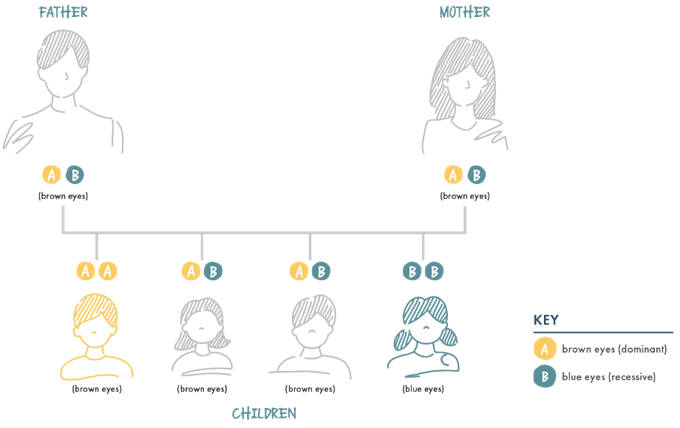
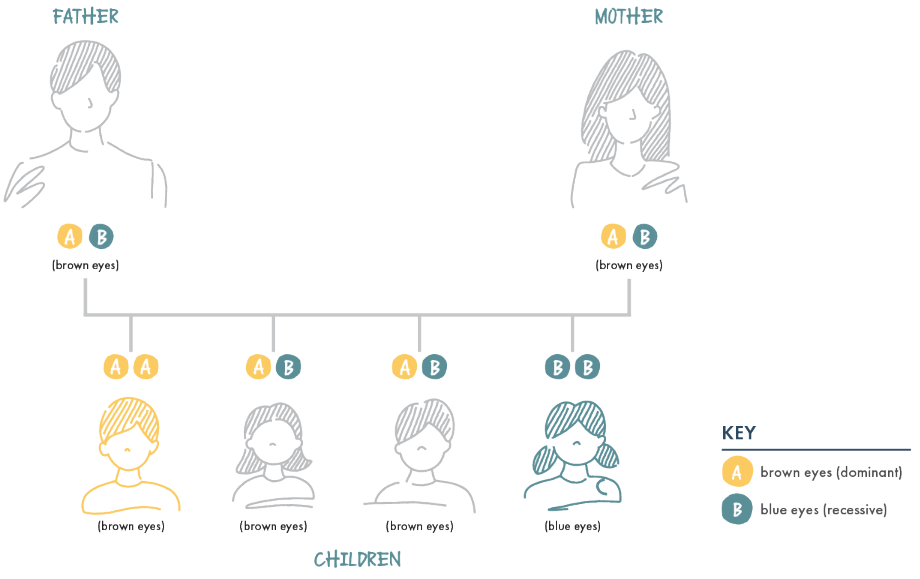
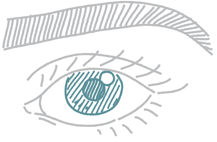

It’s easy to see why your genes are so important, since they are responsible for creating the proteins that tell your body how to work, look, and function. Let’s take a closer look at the protein within red blood cells that is affected by beta-thalassemia.
Red Blood Cells and Hemoglobin
Red blood cellsRed blood cella hemoglobin-containing cell that carries oxygen throughout your body play an important role in your body. Their job is to carry oxygen from the lungs to all of the cells throughout your body. Oxygen is like your body’s fuel—it is used to create energy.
Like all cells, red blood cells rely on a protein within the cell to do the actual work. In red blood cells, this protein is called hemoglobinHemoglobina protein in your red blood cells that helps carry oxygen throughout your body; healthy adult hemoglobin contains iron and a balanced amount of beta‑globin and alpha‑globin proteins. The hemoglobin in your red blood cells does the work of carrying oxygen throughout your body. When red blood cells are healthy, each cell is densely packed with hemoglobin.
How Hemoglobin Is Formed
Immature cells referred to as blood stem cellsBlood stem cellan immature cell that has the potential to develop into all types of blood cells, including white blood cells, red blood cells, and platelets go through several steps to become red blood and other cells. When blood stem cells mature into red blood cells, their genes instruct the cell to begin creating a protein called hemoglobin.
There are 2 main types of hemoglobin that can be found in your body: fetal hemoglobinFetal hemoglobincontaining 2 alpha and 2 gamma subunits, fetal hemoglobin is the dominant form of hemoglobin in the fetus from conception to birth. It plays a key role in the transporting of oxygen from maternal to fetal circulation and adult hemoglobinAdult hemoglobinconsists of 4 protein subunits: 2 subunits of beta-globin and 2 subunits of a protein called alpha-globin, which is produced by the HBA gene. Both types of hemoglobin help red blood cells carry oxygen, but they function at different times in your life.
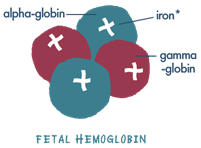
Fetal Hemoglobin (also known as HbF):
- Made before you are born
- Mainly functions while a child is in development in the womb
- Made up of a combination of proteins: 2 gamma (γ)-globinGamma-globinknown as HBG1 and HBG2, these genes are created in the fetal liver, spleen, and bone marrow. Two gamma proteins combined with 2 alpha proteins make up fetal hemoglobin, which is normally replaced by adult hemoglobin at birth and 2 alpha (α)-globin proteins
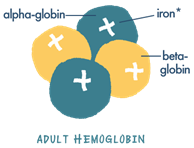
*iron depicted in globins is part of the
hemeHemea non-protein component of hemoglobin that binds to globin proteins and iron which can bind or release oxygen group
Adult Hemoglobin (also known as HbA):
- Made shortly after birth
- Replaces fetal hemoglobin
- Accounts for most of the hemoglobin present from infancy into adulthood
- Made up of a combination of proteins: 2 alpha-globinAlpha-globinproduced by the HBA gene, the 2 subunits of the alpha-globin make up half of the 4 protein subunits found in adult hemoglobin and 2 beta-globinBeta-globinproduced by the HBB gene, 2 subunits of the beta-globin make up half of the 4 protein subunits found in the adult hemoglobin proteins
A balance of both alpha- and beta-globin proteins is needed to make healthy adult hemoglobin. But with beta-thalassemia, the body produces reduced or no beta-globin. This means that the body can’t make enough hemoglobin, which is needed to help your red blood cells carry oxygen to all parts of your body.
Hemoglobin Switching
Shortly after birth, the body starts producing adult hemoglobin instead of fetal hemoglobin. This transition is known as “hemoglobin switching.”
Both fetal hemoglobin and adult hemoglobin carry oxygen. Fetal hemoglobin holds oxygen more tightly than adult hemoglobin. Because the womb is an environment with a low oxygen pressure, it makes it easier for fetal hemoglobin to deliver oxygen throughout the body as the fetus develops. After birth, however, adult hemoglobin becomes the main form of hemoglobin, as it is better suited to delivering oxygen in the body’s new, relatively higher-oxygen-pressure environment.
 SWIPE OR ROTATE
SWIPE OR ROTATE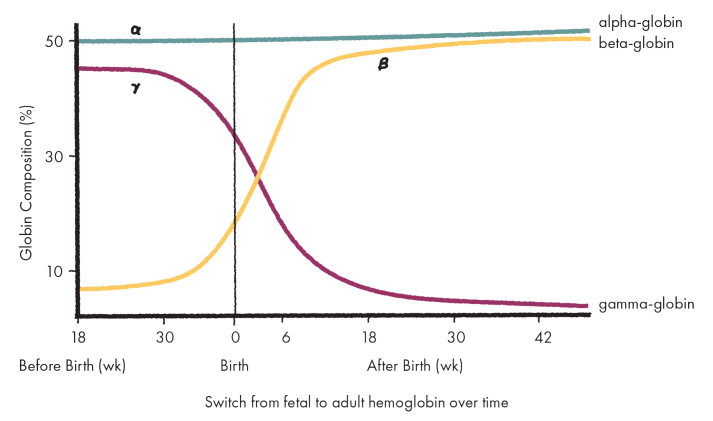
Understanding Blood Count and Hemoglobin Levels
The most common blood test you or your loved one will receive is the complete blood count. The complete blood count is a series of tests that determine the number of red and white blood cells a person has, as well as the level of hemoglobin in their blood. The results from the complete blood count will help a hematologist determine how well a person’s red blood cells are carrying oxygen throughout their body, indicating the level of anemia.
Your hemoglobin level is measured as the amount of hemoglobin in grams (g) per deciliter (dL) of whole blood, with a deciliter being 100 milliliters (mL). The normal ranges are as follows:
 This website is developed by bluebird bio, Inc. and is intended for residents of the United States who are 18 years and older.
This website is developed by bluebird bio, Inc. and is intended for residents of the United States who are 18 years and older.